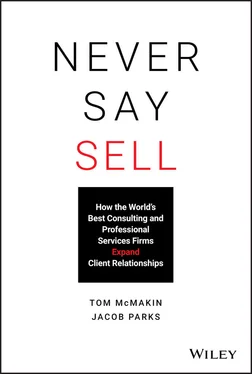Hurdle 1: We are not known outside a small cadre of people with whom we are collaborating on a specific project. We lack broad awarenesswithin the client organization.
When we work with a client, they know what we do.
Maybe you offered to audit their marketing mix and how efficiently their spending was generating traffic. When you show up in their offices, they know you to be the “marketing analytics team.” They definitely know what you do and your capabilities, because when they first engaged with you, they called references and asked questions like, “Did you feel like the quality of their marketing analytics work stood up to firm-wide scrutiny?” You know they understand what you do because when they have a problem making sense of marketing data given to them by online sites or media buyers, they turn the data over to you and ask you to make sense of it for them.
But perhaps they've come to think that your firm only specializes in marketing analytics. Do they know your firm also does media buying, graphic design, and copywriting? Or do they just think of you as the data folks?
Hurdle 2: The full range of our capabilities is not known – even to clients who know us well – because they have come to define us in terms of the capabilities we offer them now. They lack a complete understandingof all the services we are equally capable of offering them.
Our clients would not have engaged with us if we had not been responding to a felt need on their part. All business objectives lace their way through an analysis of causes and a strategy on their way to a statement of a problem to be solved. For example, a client may want to raise revenues and decides that its poorly trained sales force is the reason it is not selling as much as benchmark companies. The chief sales officer of a company asks her head of training to throw out a net to people they know to identify great sales trainers. Your name is given to the head of training by a satisfied client who was asked for suggestions, and you get the gig. Perfect. In short order you're invited to solve precisely the kind of problem you have decades of experience addressing.
But, once you're in and doing your thing, there's no guarantee you'll get a shot at the next problem you are qualified to solve. Maybe you do some sales trainings that go well. But you quickly see that the client also needs to do a better job of recruiting experienced salespeople and updating their compensation system to better align with the goals they are trying to achieve. However, your project lead inside the company, the head of sales training, has a single task he or she has been assigned – to beef up sales training – and has no interest in your other ideas or services. You don't have access to the chief sales officer who decided the secret to more sales is better sales training, leaving you unable to get either the chief sales officer or the head of sales training interested in your additional services.
Hurdle 3: Our client has identified a nail and we were hired as a hammer. Sometimes, however, we see a problem where a Phillips-head screwdriver is a better solution, but the buyer with whom we are working has no interest.
We've earned credibility when a client knows and respects our work. A client might say, “Joe was on my team when I was at AT&T. He's on his own now, but no one knows revenue recovery better.” If you're Joe, this is the kind of experience-based recommendation that leads to new work. Hopefully, once we are engaged with the client, our work is shining on its own, lighting the way to new engagements. When we first pitched the client, we were at a disadvantage, having to talk about our work. Expert services work, however, is better demonstrated than described. When we work next to someone in the trenches, we may come to believe he or she is tenacious, insightful, highly capable, and possessed of sound judgment. Once we are working on a project inside a client, the credibility bar is much lower than when we were on the outside peeking in. They have seen first-hand that we can do the work.
This is harder, though, when we try and do work for new buyers within a client who don't know us, or when we try to tell current buyers that we're capable of different kinds of services.
Hurdle 4: Our client knows the quality of our work, but we struggle to get others in the organization to see that quality. Or, we do good work and offer to perform a new service only to find our clients think of us as a one-trick pony. Our credibilityis hard to scale – across services and across relationships.
When we work with clients, we have the opportunity to do the right thing when their backs are turned, and we can demonstrate that we can be trusted with caring for their interests.
We are sometimes given a choice between leaning in the direction of our client – prioritizing transparency and investing in the relationship – or leaning in the direction of ourselves and our interests. Say, for example, you're in a meeting with your buyer and her boss, presenting to the boss on the results of a project you've just completed. Her boss is giving you high praise for the work your firm has done. You notice your buyer looks frustrated for the lack of acknowledgment she's getting (even though you did in fact do 90% of the work). One option is to accept that praise fully and take this as an opportunity to try to win more work from the boss. Instead, you use this as an opportunity to praise your buyer in front of her boss – underscoring the team effort of the project and how great she was to work with. This is how trust is created – one act at a time. You're investing in the long game.
Once we are working with a client, we no longer need to say, “You can trust me!” We have been afforded the opportunity to show our clients we have their best interests at heart.
But, like credibility, trust doesn't transfer quite as easily as we might like to other potential buyers in the client company. The more degrees of separation from our buyer, the less you can lean on your hard-earned trust. Client organizations can be big – perhaps hundreds of potential buyers – and the further away from our buyer we get, the harder we have to work to rebuild trust with others. Additionally, we often run into competing circles of trust – where incumbent relationships may box us out from even being able to prove our integrity.
Rob Benson, chief sales officer for Kele Inc., explains,
If you're in there doing something really well, you may want to offer another service that your company provides. If the customer has an incumbent in there doing those services already and they're doing a really good job, it can be hard to win that business, especially if that incumbent is doing a good job and the customer does not see a need to make a change. It's a risky situation because if you're saying, “Oh, just give us a shot. Give us a try,” that's risky as that could cause the customer to consider other options for your existing services. It can be tough to break through that incumbent relationship.
When trying to walk across a client company, we need to remember that our credibility – our reputation for doing work – often travels more easily than our ability to prove our trustworthiness.
Hurdle 5: Our client trusts us implicitly, but our reputation for being trustworthy doesn't always travel as quickly or as broadly as we'd like. Just because our buyer trusts us, does not mean that the buyer's counterpart in Johannesburg will trustus automatically. There may also be competing circles of trust that hinder our ability to even prove our integrity to other potential buyers in the organization.
Читать дальше












